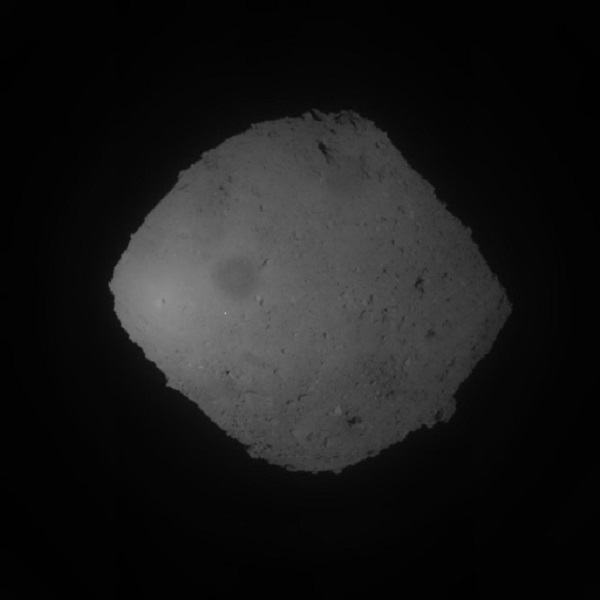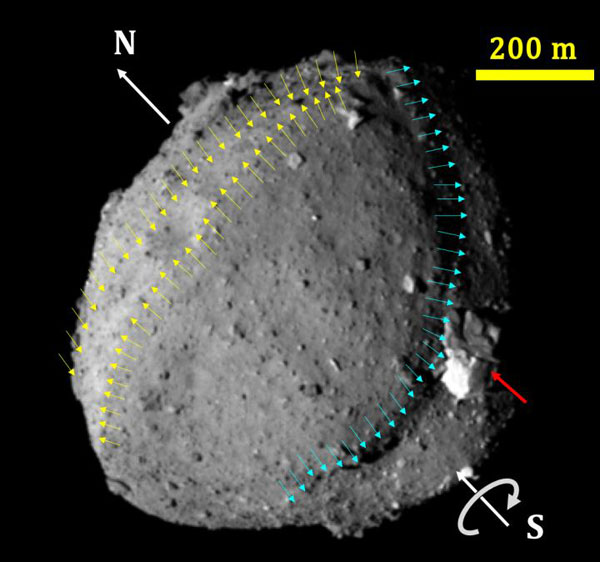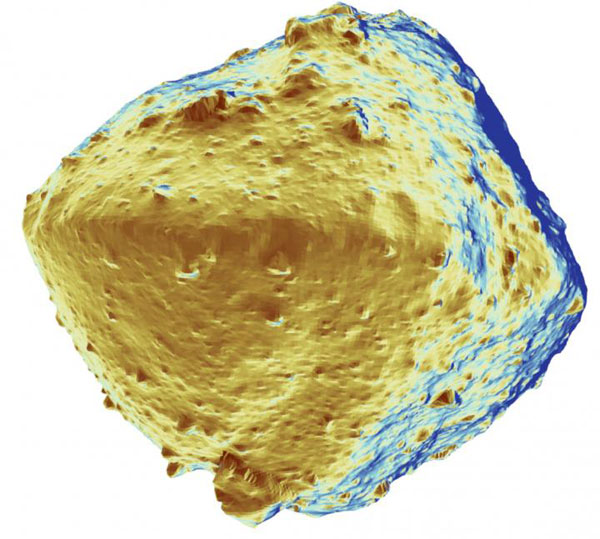Hayabusa 2’s asteroid Ryugu has some unexpected characteristics. In particular, its dry surface could spell trouble for current theories about how Earth obtained its water.

JAXA / University of Tokyo and collaborators
It’s the week of the asteroids! During the Lunar and Planetary Science Conference held in Texas, the two mission teams — NASA’s Osiris-REX and the Japanese Aerospace Exploration Agency’s Hayabusa 2 —updated the community on their explorations of near-Earth asteroids. The presentations were accompanied by images and data, as well as a slew of papers in the journals Nature, Nature Astronomy, and Nature Geoscience.
We’ve already reviewed NASA’s Osiris-REX findings on the asteroid 101955 Bennu. Now let’s take a look at updates from the team behind Hayabusa 2, in orbit around 162173 Ryugu. The Japanese team is a bit ahead of their American counterparts, having arrived roughly six months earlier. Upon approach, the team found the same kind of unexpectedly rough terrain that NASA ultimately found at Bennu: Ryugu is peppered by boulders and rocks several meters in diameter, which threaten the spacecraft as it retrieves samples from the surface.
While the Osiris-REX team is still planning the spacecraft’s descent to Bennu, Hayabusa 2 has already successfully deployed three rovers that snapped pictures as they hopped around the asteroid's surface. The mothership has also already completed one of the three expected touchdown maneuvers.
During these touchdowns, the spacecraft extends a sample retrieval mechanism, which looks like a 1-meter-long limb that ends in a canister for gathering samples. When the canister is close enough to the surface, a special mechanism within the limb shoots a pinball-sized bullet to the asteroid’s surface, stirring the regolith in the hopes that some of the surface material will end up inside the canister. Earlier this month, the team released footage of the first attempt. The researchers expect to have more material than they originally planned to collect, since the bullet created a more lively reaction than they’d predicted — it jostled nearby rocks up to 1 meter in diameter.
However, there is no way to know for sure how much they obtained, since the spacecraft has no mechanism to weigh or estimate what’s inside the sample chamber. “This is to keep things interesting until the Earth return,” joked mission program manager Yuichi-Tsuda (JAXA’s Institute of Space and Astronautical Science) during the press conference. “It’s like a souvenir present box.”
Ryugu: Like and Not Like Bennu
Ryugu and Bennu are so similar in appearance, it’s hard to tell them apart in images. Both have been called “rubble-pile asteroids,” collections of a variety of different-sized debris held together by gravity. Their low densities imply their interiors are full of hollow spaces, like Swiss cheese. These objects probably came together out of the pieces left over from larger asteroids, which may have come apart during impacts in the early solar system.
Both objects are shaped like spinning tops, as their rapid rotation causes a ridge to form along the equator. But while Bennu’s rotation is accelerating, Ryugu appears to have slowed down, and it’s unclear why. It’s current rotation period is 7.6 hours, but researchers estimate that at some point in its past, it must have rotated more quickly, with a period as short as 3.5 hours, in order to acquire its current shape.

© 2019 Seiji Sugita et al., Science
The two have plenty in common, though. Researchers don't yet know the objects' true ages, but based on collisional probabilities, Bennu is likely between 100 million and 1 billion years old, while Ryugu is likely no older than a few hundred million years.
Ryugu is also about as dark as Bennu: both reflect on average 4% of sunlight, a third that of the Moon, making them some of the darkest objects in the solar system. Researchers have matched Ryugu’s observed surface color to two asteroid families in the main asteroid belt, called Polana and Eulalia. The similarity points to one of these groups as Ryugu’s most likely family of origin.
Despite their similarities, the two are unexpectedly different in the amount of water that researchers have found on the two asteroids. While there are hydrated minerals on both objects, Ryugu appears to be much dryer than researchers expected, which suggests that its parent body didn’t have much water either. This is in contrast with Bennu, which has more abundant hydroxyls. These molecules contain hydrogen and oxygen atoms bonded together and are probably associated with clay minerals, hinting at past interactions with water.
Unraveling why the two asteroids have different water content will be important for understanding how Earth obtained its water. Solar system formation models often assume that most of the water found on Earth today arrived onboard meteorites and comets both from the asteroid belt and from the outer rims of the solar system. The existence of dry asteroids in Earth’s neighborhood could mean that these models need to be adjusted.

© 2019 Seiji Sugita et al., Science
Next Steps: Fire the Cannon!
The next step for the Hayabusa 2 mission doesn’t sound very high-tech but it’ll be spectacular. On April 5th the spacecraft will fire a 2.5-kilogram (5.5-pound) projectile at Ryugu In order to create an artificial crater on its surface. The team has already designated what point on the surface they want to blast and aims to make a hole at least 10 meters wide and 1 meter deep.
With this maneuver, the team expects to learn more about how asteroids react to impacts, which will help scientists better understand Ryugu’s history and evolution. Information about the impact might also come in handy in case one of these things ever comes too close to Earth, and we have to blast it out of the way.
Creating the crater will also enable researchers to peek at what lies below the surface. Two weeks after shooting the cannon, Hayabusa 2 will attempt a second sampling maneuver, aiming for the bottom of the crater. Then, in November or December this year, the spacecraft will start its one-year return trip to Earth.
 1
1









Comments
Jakob
April 7, 2019 at 6:35 am
Javier,
When can we expect reports of the blast ?
You must be logged in to post a comment.
You must be logged in to post a comment.